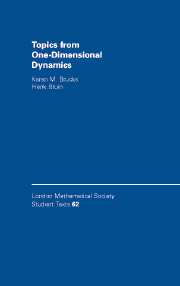Book contents
- Frontmatter
- Contents
- List of Figures
- Preface
- 1 Topological Roots
- 2 Measure Theoretic Roots
- 3 Beginning Symbolic and Topological Dynamics
- 4 Beginning Measurable Dynamics
- 5 A First Example: The 2∞ Map
- 6 Kneading Maps
- 7 Some Number Theory
- 8 Circle Maps
- 9 Topological Entropy
- 10 Symmetric Tent Maps
- 11 Unimodal Maps and Rigid Rotations
- 12 β-Transformations, Unimodal Maps, and Circle Maps
- 13 Homeomorphic Restrictions in the Unimodal Setting
- 14 Complex Quadratic Dynamics
- Bibliography
- Index
11 - Unimodal Maps and Rigid Rotations
Published online by Cambridge University Press: 05 August 2012
- Frontmatter
- Contents
- List of Figures
- Preface
- 1 Topological Roots
- 2 Measure Theoretic Roots
- 3 Beginning Symbolic and Topological Dynamics
- 4 Beginning Measurable Dynamics
- 5 A First Example: The 2∞ Map
- 6 Kneading Maps
- 7 Some Number Theory
- 8 Circle Maps
- 9 Topological Entropy
- 10 Symmetric Tent Maps
- 11 Unimodal Maps and Rigid Rotations
- 12 β-Transformations, Unimodal Maps, and Circle Maps
- 13 Homeomorphic Restrictions in the Unimodal Setting
- 14 Complex Quadratic Dynamics
- Bibliography
- Index
Summary
In this chapter we present results of [48] proving that, given any p ∈ [0,1]\ℚ there exists a unimodal map ƒ such that (S1, Rρ) is a factor of (ω(c, ƒ),ƒ) (recall Remark 3.3.2 for the definition of factor). One might ask whether one can obtain the stronger result of conjugacy? As S1 is not homeomorphic to a Cantor set, and in this setting ω(c, ƒ) is indeed a Cantor set, a conjugacy is not possible. See [48, 47] for further details and results.
Chapter 3 and Sections 6.1, 7.2, and 8.3 contain background material for this chapter.
Adding Machines in Unimodal Maps
Given a unimodal map ƒ with turning point c and kneading map Q(k), we construct an adding machine (ω,P) from the sequence of cutting times {Sk}. In the event that limk→∞Q(k) = ∞, we have that (ω(c, ƒ),ƒ) is a factor of (Ω, P) (Theorem 11.1.15). The condition limk→∞Q(k) = ∞ is not required to define the adding machine (ω, P), but rather comes into play for the continuity of the map P. In this section we provide only the information on the adding machine (ω, P) needed to obtain Theorem 11.1.15; see Section 13.3 for a more detailed discussion of (ω,P).
Let S0 < S1 < S2 < S3,… be the sequence of cutting times for some unimodal map ƒ (recall it is always the case that S0 = 1 and S1 = 2). We do not assume that limk→∞Q(k) = ∞.
- Type
- Chapter
- Information
- Topics from One-Dimensional Dynamics , pp. 178 - 192Publisher: Cambridge University PressPrint publication year: 2004



